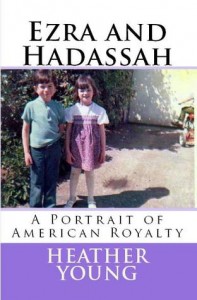Review
======
 Title: Ezra and Hadassah, a Portrait of American Royalty
Title: Ezra and Hadassah, a Portrait of American Royalty
Author:Heather Young
Publisher: CreateSpace (https://www.createspace.com/4522786)
Genre: Non-fiction
Year: 2013
Pages: 240
Binding: Paperback
ISBN-13: 9781494311162
Price: $14.00 (Kindle edition also available)
Reviewed by Jaymie Reynolds for the Association for Mormon Letters
“My first memory of life doesn’t begin with my biological parents. My memory begins at the foster home … ” A somewhat innocuous beginning to a story riddled with hard topics. As a reviewer, I almost passed this book by. I was rather hesitant to read a book that centered around the content I knew this book contained. Stories of child abuse, even when told by a survivor of such, are rarely uplifting or positive in any way. They may be cathartic, but they are, more often, rooted in anger and frustration that passes easily from the words of the author to the heart of the reader. That being said, Heather Young’s book, “Ezra and Hadassah, a Portrait of American Royalty,” is a surprising find.
Within the pages of this book, one finds the expected elements of a horrible, abuse-filled childhood. What is missing from the pages for the most part is the vituperative anger one so often hears in this type of memoir. Young’s voice is, in general, pragmatic and, at times, even positive. She strikes a nice balance in telling her tale — giving enough detail to help readers understand and sympathize, while avoiding the graphic descriptions so common in this field of content. Child abuse is a tragic reality in the world today, and Young promotes awareness of it in a way that is heartfelt and non-abrasive.
Young and her brother are the key players within this book. Somehow, despite all odds, each child grew into an adult who found something better than they’d known. Each of them found peace in their own way. Young is very honest about both of their journeys and the steps that led them to their adult selves. Surprisingly, even the most painful parts of Young’s work are presented in a way that still seems to encapsulate a glimmer of hope. This book is lacking the overall negative mood that so many of its contemporaries encapsulate. That’s not to say Young glosses over critical details or tries to pretty up ideas and events that cannot be made beautiful regardless of how they’re presented; rather, she manages to discuss difficult things in a way that invites readers to empathize and want to read on.
The target audience for this novel is at once both extremely broad and exceptionally narrow. Young doesn’t seem to be speaking to a specific demographic. Child abuse and systematic failures to protect little ones are topics that crave awareness within all venues. At this time in history, advocacy is not limited to specific readers. However, the audience that will seek out such writing may be more narrow, especially within the LDS community. The topics that are built into Young’s life experience are challenging to digest, and many may choose to avoid related works in order to focus on things they find joy in.
Latter-day Saint readers will likely be comforted at Young’s tone. Her feelings about her experiences and their aftereffects are clear, but she avoids most of the verbal landmines that may rile or upset readers. These readers may be somewhat startled to find that this story is presented in a way that invites them to support the author and hope for her success rather than in a way that would prompt them to feel attacked. Even though the role of some members of The Church of Jesus Christ of Latter-day Saints factors negatively in Young’s life, she is fair in her presentation of both the positive and negative examples she’s seen within the Church. She presents her tale in a way that recognizes the fallacy of human nature and the infinite good that can as easily be found within the hearts of other people all within one community or religion.
While Latter-day Saint readers will likely be pleasantly surprised at how Young presents her story, there are a few small elements that may be uncomfortable for some readers. Aside from the inherent painfulness of the topics Young has been forced to confront in her life, she does use a few, small swear words in her descriptions. Within context and based on her experiences, these words do not detract from her work, but they may upset sensitive readers. In addition, some LDS readers may be uncomfortable with small discrepancies as Young explains basic LDS doctrines. Overall, Young does a fantastic job giving LDS and non-LDS readers sufficient, accurate details in order to understand religious and doctrinal references. One that readers may take exception to, however, is Young’s explanation of the Word of Wisdom. This elucidation comes as Young tells of buying marijuana as a means of helping her terminally ill brother with chronic pain. She explains that she knew he would not smoke it because the Word of Wisdom “forbids smoking, drinking coffee, caffeinated tea, and alcohol.” She fails to mention illegal drugs.
In spite of small discomforts and inherently painful topic matter, taken as a whole, Young’s memoir is both well-written and is smoothly read. Perhaps what makes Young’s offering so valuable to readers is the triumph that is found in the ashes of many fiery challenges. These pages are riddled with sorrow and pain and still manage to convey hope and pull readers along to a place of peace and victory. As one who picked up this book with some hesitation, I would not hesitate to recommend that Young’s tale be added to the field where advocacy and change grow. Ezra and Hadassah is not an easy read, but it is a positive one.
